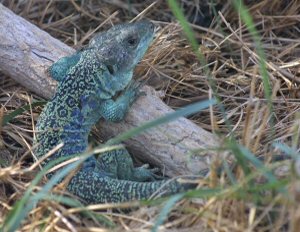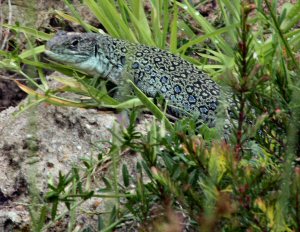
The Eyed Lizard - Timon Lepidus (formerly Lacerta lepida)(Tunisian Eyed Lizards (T. pater) and Moroccan Eyed Lizards (T.tangitanus) are similar - see footnote) IntroductionThe Eyed Lizard, sometimes also known as the Jewelled Lizard is undoubtedly one of the most spectacular lacertids. It is certainly the largest of the European Lacertids, individuals over 800mms in length having been recorded. Even an average adult specimen will substantially outmass the other readily available species with a snout to vent length of around 230 mm (males) with the tail up to 1.5 times longer than this a total approaching 600 mm. They are found in Southern Europe but only in the Iberian peninsula can they be regarded as common. As if the sheer size was not spectacular enough the colouration can be equally splendid. Throughout life, they are covered with numerous quite large occelli. As adults, those on the flanks are filled with an often brilliant blue. In some individuals, such as the beautiful male in the picture below these extend also onto the back. The body colour can be a plain grey (sub-species nevadensis) but is generally a shade of green - sometimes as bright as in the Green lizard.. As the picture shows, the normal differential in male female head sizes becomes even more pronounced in this species to the extent that an adult male can appear almost "top-heavy"!
AccommodationThese splendid animals, unlike most other Lacertids, will thrive in both indoor and outdoor vivaria. The male above has lived indoors, in an unheated greenhouse and in an outdoor vivarium throughout his life and is in his 27th year at the time of writing. They do need substantial space so, indoors, a minimum size of around 1.3 metres x 60 cms is necessary for a pair. Further accommodation might be necessary to segregate the female if she becomes gravid repeatedly. AMENDED SEPT 2017 Originally I stated that "Males are amazingly un-aggressive towards one another but females should not be kept together". This should be corrected to read that "Males are amazingly un-aggressive towards one another IN THE TOTAL ABSENCE OF FEMALES and if well fed. And by total absence I mean not even within smelling distance of females. I would NEVER recommend keeping more than one male with females, ideally 1 male to 1 female." Exceptionally, females that have been reared together since hatching may cohabit successfully. Hibernation is essential to continued breeding and a long life-span.The vivarium should be a semi-desert set up. Hiding places must be provided and ideally the vivarium should contain a substantial heap of sand for burrowing as well. Having said this, unlike most lacertids they will do well in a more sterile environment. A clean water bowl should be provided but the vivarium should also be lightly sprayed each morning to represent dew as some individuals will only drink this way. They must have good UV lighting and a substantial temperature gradient. The ambient temperature during the summer should be around 25-30ºC during daytime in the summer with a basking hotspot of around 40ºC. At night the temperature should drop to around 15ºC. During the winter, the overall temperature should be held between 5 and 10º. So far as outdoor accommodation is concerned, due to their size, only the very largest cold frame is suitable and would accommodate a pair as noted above. In these circumstances it is not normally necessary to segregate male from female due to overbreeding as only one or two clutches will be produced each year. Being large powerful lizards, soil type is of less concern as they can burrow through almost anything. I had a male who dug to 30 cms depth and then a 2 metre long horizontal tunnel through heavy clay. This also underlines the necessity for rendering the vivarium escape proof using well packed substantial hardcore. A south facing sand heap will provide a good egg-laying location and they will usually readily use artificial hibernacula. Being a larger lizard, they appreciate larger vegetation. Heaths and heathers are still good but outdoors even bushes up to 1.5 to 2 metres will be used. More substantial accommodation is better still and will allow more animals. In the south of the UK a large outdoor vivarium and throughout the UK, an unheated greenhouse, will be suitable. It is probably best to keep them in pairs to avoid rivalry between females. Thus a 1.8 x 1.2 could be divided into two 0.9 x 1.2 vivaria. Obviously, in the case of a greenhouse, UV transmitting acrylic should be used. In addition, one or two panes could be removed from the roof during the summer. With a large outdoor vivarium it should be possible to keep more animals together although a very careful eye should be kept open for inter-female aggression. BreedingMating takes place during the late Spring and is typical of lacertids (see our Breeding pages). After a period of 1 to 2 months the female will be extremely fat - individual egg bulges are often visible. She will usually dig one or two test burrows in a warm spot before choosing where to lay the eggs. She will lay anywhere from 8 to 25 eggs and, ideally, these should be dug up and incubated artificially. When the young hatch, they will usually start feeding within 24 hours of birth.In optimum conditions, the adults will mate again and
produce a second clutch about 6 weeks after the first.
In indoor vivaria this is likely to be followed by a
succession of clutches. Sadly, this quickly depletes the
female's resources and does NOT represent typical wild
behaviour. As a result, after a second clutch, the male
and female should be segregated until the end of the
season. This is probably the only factor that prevents
them from being an almost ideal indoor vivarium lizard. FeedingThese are primarily insectivorous lizards and should be fed a suitable range of insects. When fully grown they can handle any of the invertebrates listed in our live foods page. These should be gut loaded and dusted with a suitable multivitamin powder. In addition as large animals they will benefit from the occasional pinky and some individuals will eat plant matter - dandelion flowers are often appreciated! If you are fortunate enough to have them breed then hatchlings/juveniles require small to medium insects - all but adult crickets are good as are mealworms or other similar sized prey. Gut-loading and vitamin dusting are essential. Obtaining your animalsThese are occasionally seen in pet shops usually as long term captives that are no longer wanted. Also young can be found in most years and these are almost invariably captive bred. There are a number of UK breeders so this should prove one of the easiest species to obtain. For some (and so far as I am concerned, strange) reason these are not included on the list of European Protected Species. Very similar species, although not as hardy, are Timon pater and Timon tangitanus. These are slowly becoming available from captive breeders. They should thrive in a greenhouse in southern England but will probably require indoor vivaria elsewhere in this country. All three species make excellent vivarium animals. They can become extremely tame - especially the males which can, with patience) rival a Bearded Dragon in terms of tameness. |
||||||
|
Next - Podarcis muralis - the Wall Lizard
|

